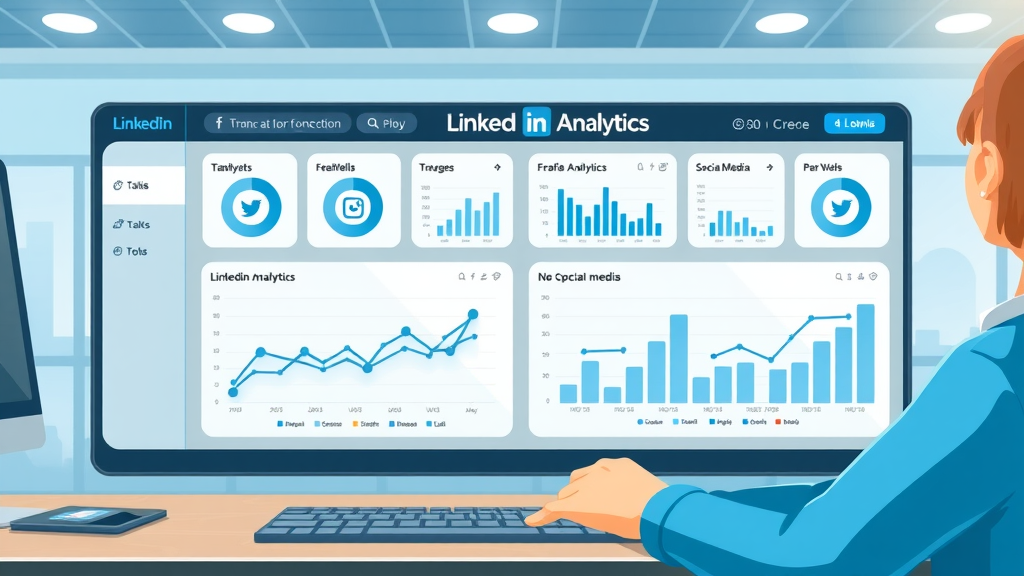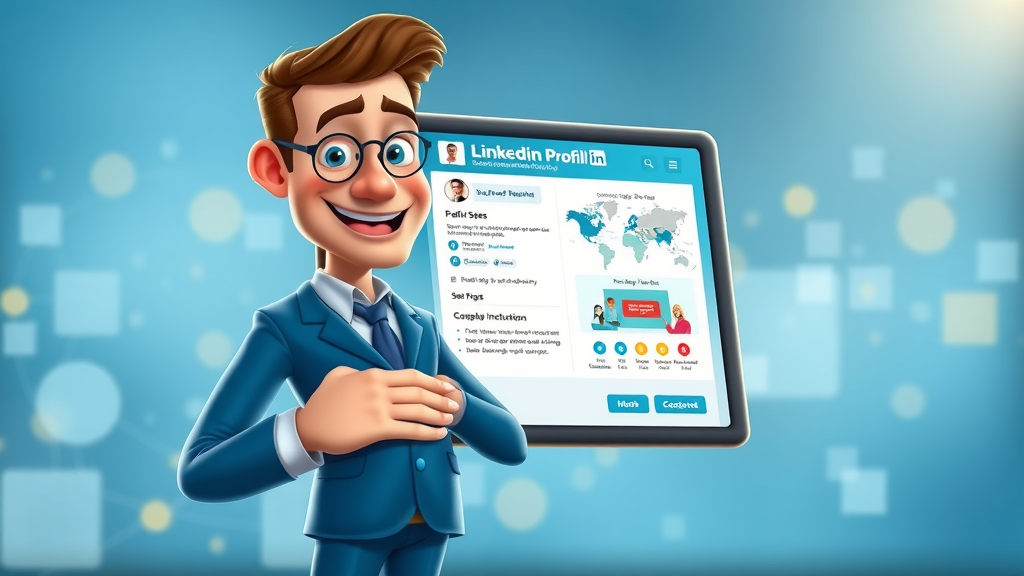Did you know that 80% of B2B leads generated through social media come from LinkedIn , but most small businesses still overlook its potential? In today’s fast-paced digital landscape, ignoring LinkedIn marketing could be the costliest mistake your business makes. In this comprehensive guide, you'll learn how to sidestep common pitfalls, build a high-impact LinkedIn marketing strategy, and ensure every dollar spent yields a measurable return. Whether you want to generate more leads , increase brand awareness , or simply drive sales growth, mastering LinkedIn marketing for small businesses is your next big move.
“80% of B2B leads generated through social media come from LinkedIn, yet most small businesses underutilize this powerful platform.”

- Strategies to create an impactful LinkedIn marketing strategy
- Step-by-step directions to optimize your LinkedIn company page and profile
- Practical insights to avoid the most common LinkedIn marketing pitfalls
- Proven tips for lead generation via LinkedIn ads
- Actionable content and social media marketing tools for small businesses
Why LinkedIn Marketing for Small Businesses Is a Game Changer: Eye-Opening Facts
LinkedIn has evolved from a simple professional networking site into one of the most influential lead generation platforms for businesses of all sizes. For small businesses , the ability to connect directly with decision-makers, showcase expertise, and drive brand awareness is unmatched in the social media landscape. As the leading social network for professionals, LinkedIn empowers small businesses to generate leads , establish thought leadership, and create a marketing strategy that’s both targeted and cost-effective.
What sets LinkedIn apart from other social media tools is its laser-focused targeting capabilities. With advanced filters for job title , industry, company size, and location, small businesses can tailor their messaging directly to their ideal target audience . The result? Significantly higher conversion rates and a greater return on investment compared to more generalized social platforms . LinkedIn ads and sponsored content further amplify reach, making it easier than ever to drive traffic and build relationships that lead to actual business growth.
The proof is in the numbers: small businesses successfully leveraging LinkedIn marketing see dramatic improvements in lead quality and volume. With over 900 million members worldwide, your prospects are already on LinkedIn—now is the time to create a targeted action plan and grow your business through proven strategies.
Understanding LinkedIn Marketing for Small Businesses
The Power of LinkedIn Marketing for Small Businesses in a Social Media-Driven Era
In a marketing world dominated by rapid-fire content and fleeting attention spans, LinkedIn marketing for small businesses enables you to cut through the noise. Unlike other social media platforms, where personal updates and viral trends often take center stage, LinkedIn prioritizes professional content that adds value . This focus makes it ideal—not just for recruitment, but for tangible business development and brand building.
With LinkedIn’s clever integrations, such as the LinkedIn company page and showcase pages , small businesses can consistently communicate their brand vision and expertise. Whether you’re sharing a breakthrough case study, highlighting a new product, or announcing a big win, each LinkedIn post reaches an audience primed to engage and do business. Lead generation is further streamlined through intuitive marketing tools and campaign management features, allowing even small teams to operate like seasoned pros.
The result? Small businesses harnessing LinkedIn marketing see accelerated lead gen , increased exposure to high-value networks, and a reliable stream of qualified opportunities. The modern era of B2B marketing belongs to those who leverage the right channels—and LinkedIn sits at the top of that list.
What Makes LinkedIn Marketing Strategy Unique for Small Businesses?
What distinguishes a winning LinkedIn marketing strategy from efforts on other social media platforms is the platform’s depth of business intelligence and professional engagement. Here, every post, interaction, or ad placement can be tailored using LinkedIn’s detailed demographic and psychographic filters—think job title , industry, company size, seniority, and even personal interests. This level of precision is rarely matched by other channels, minimizing wasted ad spend and maximizing the chance for actual connection and conversion.
Another unique advantage is the emphasis on relationship-building and credibility. Small businesses aren’t drowned out by memes or cat videos. Instead, regularly updating your LinkedIn company page with relevant, informative content not only boosts brand awareness but also positions your brand as a thought leader . Developing a robust content strategy on LinkedIn ensures that every interaction matters—from engaging in group discussions to responding to direct messages for lead gen .
Finally, LinkedIn’s robust analytics and marketing tools provide real-time data, making it easy to track marketing goals and adjust campaigns for continual improvement. Paired with tools like LinkedIn Campaign Manager and in-depth KPIs, you get the agility needed to outperform competitors and grow your business .
| Platform | Lead Generation | Brand Awareness | ROI | Cost-Effectiveness |
|---|---|---|---|---|
| High (B2B focused, advanced targeting) | Very High (thought leadership, professional reputation) | Strong (especially for B2B and service-based businesses) | Moderate-High (premium targeting, higher upfront but better long-term ROI) | |
| Moderate (broad audience, less B2B) | High (visual ads, large user base) | Variable (can be costly for B2B targets) | High (if targeting local or B2C markets) | |
| Moderate (real-time engagement, diverse reach) | Moderate (fast news style) | Average (depends on audience overlap) | High (low ad cost, fast reach) | |
| Low-Moderate (visually driven, younger audience) | Very High (influencer marketing) | Average (strong for visual products) | High (cost per ad is relatively low) |

Crafting an Effective LinkedIn Marketing Strategy for Small Businesses
Identifying and Reaching Your Target Audience on LinkedIn
No LinkedIn marketing strategy can succeed without a crystal-clear understanding of your target audience . Begin by building detailed customer personas based on job title , industry, company size, and location—key filters in LinkedIn’s robust search. This not only streamlines how you identify prospects but also ensures your content resonates and drives engagement.
Use LinkedIn’s advanced search functions and group memberships to discover where your target audience ‘hangs out.’ Are they engaging with industry-specific discussions? Which decision-makers are most active? Joining relevant LinkedIn groups and participating authentically elevates your status as a knowledgeable industry player and opens conversion pathways for lead gen .
Finally, personalize your LinkedIn posts and company page updates to address the real challenges and goals of your audience. The more relevant and insightful your message, the more it will stand out in their busy feeds—turning passive viewers into high-quality leads.
Setting SMART Marketing Goals to Grow Your Business
Every successful LinkedIn marketing strategy begins with setting SMART ( Specific, Measurable, Achievable, Relevant, Time-bound ) marketing goals . Whether your aim is to generate leads , boost brand awareness , or simply increase traffic to your website, your objectives should be clear, trackable, and aligned with broader business outcomes.
Start by identifying benchmarks using LinkedIn Analytics: What’s your current connection growth rate? How many website visits come from LinkedIn? Using these insights, set targets like “increase lead form submissions by 25% within 6 months by refining LinkedIn ad targeting.” This gives your team a shared purpose and helps focus your efforts on high-impact actions.
Remember, without measurable goals—like improving engagement rates on your LinkedIn page or achieving a certain number of post shares—you’re flying blind. Convert those targets into actionable campaigns and regularly revisit them to guarantee sustained growth and ROI.
- Overlooking audience research
- Ignoring data-driven decisions
- Underestimating the value of a well-optimized company page
Optimizing Your LinkedIn Business Profile and Company Page
Creating a High-Impact LinkedIn Profile for Small Business Owners
A professional, well-optimized LinkedIn profile is the cornerstone of your LinkedIn marketing success. It’s often the first impression potential clients and partners receive about you and your business. To stand out, ensure every section—headline, summary, and experience—is tailored to highlight your expertise, achievements, and value proposition. Use keywords like “small business marketing,” “lead generation,” and “thought leader” within your summary and job descriptions for maximum visibility in search results.
Don’t forget your profile photo and background image. These graphics should reflect your brand’s identity, fostering immediate trust with visitors. Recommendations and endorsements also enhance credibility, so request testimonials from satisfied customers or collaborators. The more robust your LinkedIn profile , the easier it will be for your target audience to recognize you as a trusted resource.
Finally, regularly update your profile with fresh accomplishments, certifications, or notable projects. This signals to prospects and the LinkedIn algorithm alike that you’re active and relevant—a critical distinction in a competitive professional landscape.
Building an Engaging LinkedIn Company Page for Small Businesses
A polished, comprehensive company page is vital for brand consistency and credibility. Begin by crafting an ‘About’ section that clearly explains your services, expertise, and what makes your business unique. Use visuals—such as banners and logo images—that align with your branding, and ensure all sections (overview, specialties, website link) are filled out in detail.
Regularly post content relevant to your audience—think case studies, success stories, how-to tips, and industry news. Encourage employees to engage with posts, as their comments and shares multiply your organic reach. Every new LinkedIn post on your company page is an opportunity to reinforce brand voice, fuel lead generation , and nurture connections.
Finally, use the analytics dashboard to track what content performs best and who engages most with your page. This invaluable data lets you tweak your approach in real time for even better results.

Showcase Pages: When and Why They Matter for Brand Awareness
Showcase pages are extensions of your main LinkedIn company page designed to spotlight specific brands, products, or initiatives. If your small business offers multiple distinct services or target markets, showcase pages let you tailor your messaging and content strategy for each audience segment—boosting both brand awareness and relevance.
Unlike your core company page, showcase pages focus solely on a single topic, allowing followers to subscribe directly to the information most meaningful to them. This targeted approach ensures every LinkedIn post reaches users already interested in that area, supercharging engagement and lead gen opportunities.
Deciding whether to create a showcase page comes down to your business structure and goals. If you see measurable variance in your buyer personas or product lines, showcase pages are a powerful addition to your LinkedIn marketing strategy .
Content Strategy for LinkedIn Marketing for Small Businesses
Developing a Consistent LinkedIn Post Schedule for Engaged Followers
Consistency is key to growing your following and amplifying engagement on LinkedIn. Develop a realistic posting schedule that ensures your audience can depend on your insights and expertise. Whether that’s three times per week or bi-weekly, stick to a rhythm that’s sustainable for your team and valuable for your audience.
A robust content calendar should feature a mix of LinkedIn post types: original articles, curated industry news, short updates, polls, and event announcements. Map your post types to specific days and time slots to optimize reach—for example, sharing thought leadership pieces on Tuesdays and quick tips on Fridays when engagement tends to spike.
Leverage analytics to refine your posting cadence. Monitor which days and times drive the most interaction, then tweak your schedule accordingly to maximize exposure and foster a loyal, engaged following.

Crafting High-Impact LinkedIn Posts: Best Content Types for Small Businesses
The most successful LinkedIn marketing strategies prioritize content that informs, inspires, and incites action. For small businesses, this means a healthy mix of educational articles, product/service highlights, case studies, and interactive posts. Content that solves real problems or provides actionable advice positions your business as a valuable resource and a thought leader.
Media-rich posts—think infographics, customer testimonials, behind-the-scenes videos, and industry trend reports—perform especially well. Not only do they break up the text-heavy nature of LinkedIn feeds, but they also make your brand more relatable and memorable. Don’t shy away from sharing your business’s milestones or celebrating customer successes—they’re proven to increase engagement and foster goodwill.
Always include a strong call to action—such as “download our free guide,” “contact us for a demo,” or “follow our page for more tips.” This directs viewers toward conversion-focused behaviors and transforms casual browsers into active leads.
Incorporating Visuals and Videos: Social Media Marketing Tools for LinkedIn
Visuals and videos are undeniable assets for cutting through the competitive noise on LinkedIn. Posts with rich media attract significantly higher engagement than those with text alone. Use company-branded graphics for consistency, and leverage short-form videos to showcase product demos, customer testimonials, or quick how-to tips.
Marketing tools like Canva or Crello make it easy to design professional infographics or quote cards—even for teams without a graphic designer. Short explainer videos or behind-the-scenes clips help humanize your small business, while slideshows or carousel posts can effectively break down complex topics.
Finally, integrate these visuals seamlessly into your regular posting rhythm. A varied content mix signals authenticity, keeps your feed fresh, and positions your brand as an innovator in your field.
Mastering Lead Generation and LinkedIn Ads for Small Businesses

Creating a LinkedIn Ad Campaign: Target Audience, Setup, and Budgeting
Building a successful LinkedIn ad campaign starts with clarity: Who is your target audience ? What do you want them to do? Use LinkedIn’s extensive targeting filters—like job title , industry, company size, and geolocation—to define exactly who will see your ads. Then, select your campaign objective (e.g., lead gen , website visits, brand awareness) to align creative and measurement.
Set a realistic budget that reflects your goals. While advertising on LinkedIn may cost more per click versus other platforms, its precision means less wasted spend. Design visually compelling ads with clear calls to action—whether driving visitors to an optimized landing page or collecting leads directly via a form.
Regularly review and tweak your campaigns during and after launch. A/B test different images, headlines, and offers to optimize performance, and don’t hesitate to pause or reallocate funds in real time for best results.
Choosing Between LinkedIn Ads Versus Sponsored Content
Two main paid solutions stand out for small businesses on LinkedIn: ads (displayed in feeds, sidebar, messages) and sponsored content (boosting your existing posts for greater reach). Ads provide advanced targeting and are highly customizable, making them ideal for singular campaigns like event promotions or launching a new product. Sponsored content, on the other hand, amplifies the reach of organic posts, helping increase visibility and engagement with content your audience already values.
When choosing, consider your goals and resources. If rapid lead generation is your aim, invest in tailored ad campaigns. If nurturing long-term relationships and boosting brand awareness is critical, sponsor your best-performing organic posts. Many small businesses find success combining both: running lead gen campaigns side by side with regular content boosting to maximize results.
Whatever you choose, make sure your creative aligns with the LinkedIn audience’s expectations for professionalism, clarity, and actionable value.
Tracking Campaign Success and Tweaking Your LinkedIn Marketing Strategy
Measuring and interpreting results is essential to every LinkedIn marketing strategy . Start by identifying key performance indicators (KPIs), such as click-through rates, leads generated, or cost per conversion. Use LinkedIn’s built-in analytics and external marketing tools (Buffer, Hootsuite) to track these metrics across your ad campaigns and regular posting activities.
Continuous optimization is the name of the game: review which ads, posts, and targeting criteria deliver the most engagement and conversions. Shift budgets and refine creatives as trends emerge. The best-performing small businesses treat LinkedIn analytics as their ongoing roadmap—fueling smarter decisions and better ROI with every campaign iteration.
Don’t just celebrate wins—learn from failures, too! Every underperforming ad offers clues for what your audience values, helping you fine-tune future efforts and avoid repeating missteps.
| Ad Type | Primary Objective | Best Use Case |
|---|---|---|
| Sponsored Content | Brand Awareness, Engagement | Amplifying posts, driving more profile visits |
| Text Ads | Traffic, Awareness | Budget-friendly campaigns targeting specific demographics |
| Message Ads | Direct Lead Gen, Engagement | Personalized outreach and event invites |
| Lead Gen Forms | Lead Collection | Instantly capturing qualified contact information |
| Dynamic Ads | Customized Engagement | Personalizing ad messages based on LinkedIn member profile fields |
Measuring the Success of LinkedIn Marketing for Small Businesses
Top LinkedIn Marketing KPIs Every Small Business Should Track
KPIs are the vital signs of your LinkedIn marketing strategy . Focus on metrics that directly relate to your objectives—connection growth, post engagement rate, leads generated, and website clicks. For paid efforts, monitor cost per click, cost per lead, and conversion rates.
Tracking your company page followers, impressions, and click-through rates gives insight into overall brand health on LinkedIn. Form submissions, event sign-ups, and direct messages are all indicators of advancing lead gen efforts. These measurements reveal what strategies drive success—and where to recalibrate.
Finally, benchmark your metrics against past performance and relevant industry averages. This allows you to set realistic growth targets and prove marketing ROI to stakeholders.
Analyzing Results: Using LinkedIn Analytics and Other Marketing Tools
LinkedIn Analytics is an indispensable marketing tool for assessing the impact of your content strategy and campaigns. Dive into dashboards to discover which posts resonate, what times see the highest activity, and who’s engaging most with your company page .
Complement LinkedIn’s native analytics with third-party marketing tools like Buffer, Hootsuite, or Google Analytics to gain deeper insights into how LinkedIn traffic interacts with your website. This detailed view allows you to attribute conversions correctly, optimize landing pages, and drive more qualified traffic back to your business.
“What can’t be measured, can’t be improved. LinkedIn analytics are your roadmap to marketing success for small businesses.”
Use these insights to continually refine your content strategy , improve targeting, and create higher-converting ad campaigns—maximizing your investment every step of the way.
Avoiding Costly LinkedIn Marketing Mistakes for Small Businesses
Common Pitfalls in Social Media and LinkedIn Marketing
While LinkedIn marketing for small businesses delivers tremendous potential, common mistakes can quickly erode your progress. One of the biggest errors is neglecting to keep your company profile up-to-date, resulting in missed connection and partnership opportunities. Failing to respond to LinkedIn messages or comments can cost you valuable leads and partnerships.
Another costly pitfall is sticking with a “set-it-and-forget-it” content approach—failing to tweak your content strategy as your business goals or audience needs evolve. Those who regularly analyze results and pivot quickly are best positioned to take advantage of emerging opportunities and trends.
Finally, avoid the temptation to chase viral trends irrelevant to your audience. Focus instead on building a reputation for expertise and authenticity, understanding that meaningful engagements matter most in driving sustainable business growth.
- Neglecting to update the company profile
- Ignoring messages and opportunities for lead gen
- Failing to adapt content strategy for business objectives
People Also Ask: Demystifying LinkedIn Marketing for Small Businesses
How effective is LinkedIn marketing for small businesses?
LinkedIn marketing for small businesses is highly effective due to its professional user base, targeted advertising features, and superior lead generation capabilities. Many businesses report stronger ROI on LinkedIn compared to other social media platforms, especially in B2B contexts.
What are the most common LinkedIn marketing mistakes for small businesses?
The most frequent LinkedIn marketing mistakes for small businesses include incomplete profiles, lack of posting consistency, neglecting analytics, misidentifying their target audience, and not leveraging LinkedIn ads or Sponsored Content.
How do small businesses get more leads on LinkedIn?
To generate more leads, small businesses should optimize both their company page and profiles, target the right audience, consistently post value-driven content, and use LinkedIn ads with precise targeting options. Engaging in groups and using showcase pages can further amplify results.
Is advertising on LinkedIn cost effective for small businesses?
While LinkedIn ads may require a higher upfront investment than some other platforms, their precision targeting and professional network make them highly effective and, over time, cost-efficient for well-defined B2B marketing strategies.
Essential LinkedIn Marketing Tools for Small Businesses
- LinkedIn Campaign Manager
- Analytics dashboards
- Content scheduling tools (e.g., Buffer, Hootsuite)
- Design tools for infographics and visuals
Actionable Tips to Grow Your Business with LinkedIn Marketing
- Use video in LinkedIn posts to boost engagement
- Regularly update your LinkedIn company page
- Set specific, measurable marketing goals
- Optimize your showcase page to highlight products or services
- Encourage employee advocacy
Frequently Asked Questions about LinkedIn Marketing for Small Businesses
How much should small businesses budget for LinkedIn ads?
A practical starting point for small businesses is $500–$1,000 per month on LinkedIn ads, testing campaigns in small increments to gauge performance. As clarity about which ad formats and target audiences work best grows, budget allocation can scale up for even greater ROI.
What are the best LinkedIn post formats for small businesses?
The most effective LinkedIn post formats for small businesses include short status updates with tips, native videos, image carousels, link shares to valuable resources, and thought leadership articles. Regularly experimenting with post types helps identify what engages your audience most.
Can small businesses use LinkedIn for hiring and company branding?
Absolutely—LinkedIn is one of the top platforms for employer branding, recruitment, and sharing company culture. Posting job openings, sharing employee achievements, and highlighting company values on your company page attract top talent and enhance your reputation as an employer of choice.
Success Stories: Small Businesses Excelling with LinkedIn Marketing

“After refining our LinkedIn marketing strategy, we saw a 250% increase in qualified leads in just 90 days.” — Local Long Island Business Owner
Ready to Make Waves on Long Island? Chart Your LinkedIn Marketing Course Now
Ready to make waves on Long Island? Let’s chart your course. https://cm2digitalenterprises.com
To enhance your LinkedIn marketing strategy and avoid costly mistakes, consider exploring the following resources:
- “How to Set Up a LinkedIn Business Account for Your Brand” ( mailchimp.com )
This guide provides step-by-step instructions on creating and optimizing your LinkedIn business page, including crafting an impactful “About” section and encouraging employee connections.
- “LinkedIn Marketing Guide for Small Business” ( uschamber.com )
This resource offers strategies for building and promoting your expertise on LinkedIn, emphasizing the importance of completing your business page and participating in LinkedIn groups.
By leveraging these resources, you can develop a robust LinkedIn marketing strategy that maximizes your return on investment and effectively engages your target audience.
 Add Row
Add Row  Add
Add 




Write A Comment